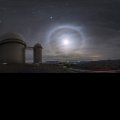
火星上空的火卫一

Phobos over Mars
Image Credit: ESA, DLR, FU Berlin, Mars Express; Processing & CC BY 2.0 License: Andrea Luck
Explanation: Why is Phobos so dark? Phobos, the largest and innermost of the two Martian moons, is the darkest moon in the entire Solar System. Its unusual orbit and color indicate that it may be a captured asteroid composed of a mixture of ice and dark rock. The featured assigned-color picture of Phobos near the edge of Mars was captured in late 2021 by ESA‘s robot spacecraft Mars Express, currently orbiting Mars. Phobos is a heavily cratered and barren moon, with its largest crater located on the far side. From images like this, Phobos has been determined to be covered by perhaps a meter of loose dust. Phobos orbits so close to Mars that from some places it would appear to rise and set twice a day, while from other places it would not be visible at all. Phobos‘ orbit around Mars is continually decaying — it will likely break up with pieces crashing to the Martian surface in about 50 million years.
Your Sky Surprise: What picture did APOD feature on your birthday? (post 1995)
Tomorrow’s picture: monster at the Sun’s edge
火星上空的火卫一
影像提供: ESA, DLR, FU Berlin, Mars Express; 影像处理及CC BY 2.0许可: Andrea Luck
说明: 火卫一为何如此黝黑?火卫一是火星的两颗卫星之中,最大和最接近火星的那颗,同时也是整个太阳系里最黝黑的卫星。它不寻常的轨道与色泽,显示火卫一可能是被火星所俘获、组成混杂了冰晶与黑色石头的小行星。这幅火卫一悬在火星临边附近的人为上色主题影像,是由目前在绕行火星的欧洲航天局火星快车号摄于2021年。火卫一是颗荒芜满布陨石坑的卫星,它最大的撞击坑位于反面。分析包括此图在内的这类影像,科学家推断火卫一表面可能有一层厚达1公尺的粉尘。由于火卫一的轨道极为靠近火星,因此部分地区一天能看到火卫一发生二次升落,也有部分地区则是一次也没见到。火卫一的轨道不停衰减,大约在5千万年内,就会崩解并撞到火星表面上。
您的天空惊喜: APOD在您生日那天上展示了什么照片?(1995年以后)
明日的图片: monster at the Sun’s edge




